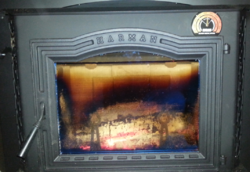very very helpful....refering to the manual....i dont think i got one with the stove.... was just warranty info with a single sheet of paper regarding the first few fires ....nothing directly as to the full operation....does the E-W apply to the placement of all the wood....i have been loading it N-S.And this is how I reload my insert after the startup fire described by velvetfoot above:
Rake most/all the coals forward towards the door, drop ~2 splits E-W behind the coals (wearing welding gloves!) creating a level surface with the coals, load more splits on top of the wood/coals until it almost hits the baffle. The tighter you can pack it the more control you should get and the longer your burn times will be. With the door slightly ajar I wait until the wood has caught fire, then close door. Let the fire establish, then start closing the air about a quarter every 5 min (your stove may differ). After every adjustment the flames should be slow moving ("lazy") but when you wait a few minutes they should get vigorous again. If they don't recover just open up the air a bit and wait for the fire to establish itself again. After 15 to 20 min air is in the final setting (maybe a quarter open to fully closed depending on your draft and wood), secondaries are blasting, stove will climb to 650 to 700 F over the next 30 min. I won't touch the stove for at least 6 hours; it will still be putting out heat and have hot coals after 10 hours. Plus, coals will be manageable as the old ones burn down with every reload.
Check with your IR thermometer the hottest spot on the black front. In my case that's in the center just above the door where it reads about 50 F less than stovetop. Get also to know the distance to spot ratio from your manual. You may need to get fairly close to the insert to get an accurate reading. I use mine from about 3" away.
hampton hi300 insert issues
- Thread starter bobby magee
- Start date
-
Active since 1995, Hearth.com is THE place on the internet for free information and advice about wood stoves, pellet stoves and other energy saving equipment.
We strive to provide opinions, articles, discussions and history related to Hearth Products and in a more general sense, energy issues.
We promote the EFFICIENT, RESPONSIBLE, CLEAN and SAFE use of all fuels, whether renewable or fossil.




